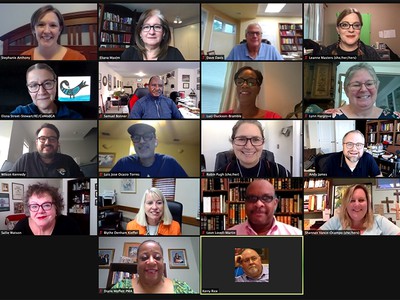The 225th General Assembly of the Presbyterian Church (U.S.A.) may be a year and a half away and the dates may not be finalized, but that hasn’t stopped the planning process. The Office of the General Assembly has been working since last summer to determine what the next gathering will look like.
The Committee on the Office of the General Assembly (COGA) voted in December to move toward a hybrid format in 2022, with in-person committee meetings to be held in Louisville and plenaries to be conducted online.
This week, COGA has been seeking input from other committees on how they think a virtual assembly could be held. On Tuesday, members heard from the Advisory Committee on Social Witness Policy and the Advisory Committee on the Constitution.
On Thursday, COGA heard from representatives of the General Assembly Committee on Representation (GACOR). Co-Moderators Byron Elam and the Rev. Anna Kendig Flores said that while they are still awaiting data on the 224th General Assembly (2020), they did have a few observations.
“One thing obvious to us in the data we collected from last summer’s assembly was the decline in participation of Young Adult Advisory Delegates,” Elam said. “Approximately 130 YAADs registered at opening session, yet the last vote of the night recorded approximately 76 YAAD votes, a 40% drop. That area is of grave concern to us. We would hope there would be some fundamental changes in that area to increase participation of YAADs even in a virtual format.”
There were other concerns regarding the mic-queuing system utilized in the online format along with the need for more transparency in the process. Both Kendig Flores and Elam believe collaboration with GACOR would be helpful moving forward.
“We are hoping to collaborate with COGA to be a resource,” said Kendig Flores. “I also think collaboration can go beyond that and engage with groups that might have representation issues to discuss for this and future general assemblies.”
GACOR representatives will work with the Design Team in the coming months to share information.
In other action, COGA this week also restructured working teams made up of staff and COGA members.
Moving forward for the near future, four teams will handle various aspects of the planning process: Design, Process & Discernment, Assembly Events and Communications. The teams will work separately and collaboratively to create a roadmap and overall plan for the next assembly.
Leanne Masters is the convener for the Process & Discernment Team.
“As we make decisions on the discernment processes, we need training for commissioners on their roles in advance of General Assembly,” she said. “There is a need for relationship and community building, and we want to include that as part of the work so we can build those connections and facilitate along the way.”
Masters told the group one of the most important tasks ahead will be to develop job descriptions for participants at General Assembly.
“This is especially for commissioners and advisory delegates, and to get those to presbyteries so people will know what the expectations are, what they will be doing and how things will be done,” she said. “We’ll look at job descriptions for committee leadership with an eye toward lifting up the voices that are less visible at the table so that leadership realizes that’s part of the job as well.”
Masters adds they also see a need for relationship and community building for the 225th assembly.
“We are able to discern together when we have the opportunity to know each other,” she said. “We want to include that relationship building and connection as part of the training so we can build those connections and facilitate along the way.”
The Process & Discernment Team also plans to collaborate with the Design Team to bring commissioners and delegates together in a “non-debate context.” Their hope is that commissioners can get information on major decisions and be equipped to ask questions and be educated on the depth of the issues.
COGA Vice Moderator Eliana Maxim says it will be important for all four teams to communicate and collaborate with each other during the planning process.
“This is another way to ensure we are all talking the same language,” she said. “We hope this will be a more cohesive way of staying in communication with each other and holding each other accountable to the Clerk’s vision. We see this as a roadmap for where we are going and how we approach our work.”
The Design Team is expected to pull together a series of deadlines for pre-assembly work by mid-April. Kerry Rice, Deputy Stated Clerk for the Office of the General Assembly, says the work will have to be a “choreographed dance” between OGA staff and COGA members to ensure the work is done.
“One of the tricks will be helping COGA focus on the bigger decisions and for staff to take those decisions and put legs on them and implement,” he said. “We will need to keep open communication so that we’re all on the same page.”
Maxim says the assemblies of the past were practically “plug and play,” in that everyone knew how things were supposed to happen.
“Now the whole table has been wiped clean and we will have to feel our way around what has to go on the table and make sure it matches up with what we’re planning,” she said. “We have to be intentional, which can be overwhelming, but it affords opportunity to be creative and think a bit differently on how we can do this.”
“What we’re doing in charting this course is to invite a more collaborative approach and different orientation to our work,” said Wilson Kennedy, COGA member. “The trust and collaborative relationship are paramount to how we will get this work done.”

